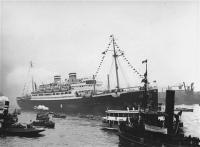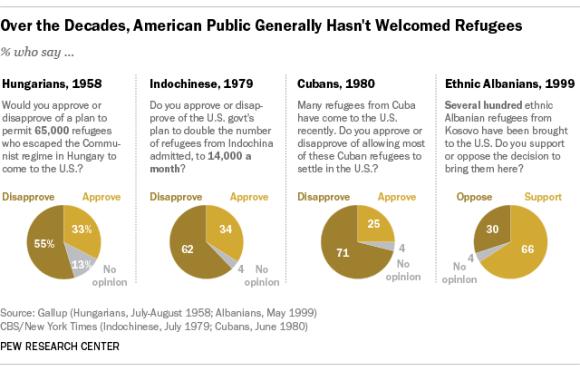 Given the current heated debate over Syrian refugees, it seems worthwhile to remember the ill-fated voyage of the German ocean liner St. Louis in 1939. The ship carried 908 Jewish refugees who were fleeing from Nazi Germany. The ship and its passengers were denied entry to Cuba, the United States and Canada. Finally, the ship turned around and returned to Europe. Despite the US government’s refusal to accept the refugees, private Jewish aid groups in the United States did manage to place most of the refugees in Belgium, France and Holland, to avoid returning them to Nazi Germany. Tragically, many were later captured when the Nazis invaded. Two-hundred-and-fifty-four of the refugees are believed to have died in the German death camps. The voyage has been the subject of at least one book and two movies. The movie, Voyage of the Damned, in 1974 was based on the book of the same name by Gordon Thomas and Max Morgan-Witts. A second movie, The Voyage of the St. Louis, was released in 1995.
Given the current heated debate over Syrian refugees, it seems worthwhile to remember the ill-fated voyage of the German ocean liner St. Louis in 1939. The ship carried 908 Jewish refugees who were fleeing from Nazi Germany. The ship and its passengers were denied entry to Cuba, the United States and Canada. Finally, the ship turned around and returned to Europe. Despite the US government’s refusal to accept the refugees, private Jewish aid groups in the United States did manage to place most of the refugees in Belgium, France and Holland, to avoid returning them to Nazi Germany. Tragically, many were later captured when the Nazis invaded. Two-hundred-and-fifty-four of the refugees are believed to have died in the German death camps. The voyage has been the subject of at least one book and two movies. The movie, Voyage of the Damned, in 1974 was based on the book of the same name by Gordon Thomas and Max Morgan-Witts. A second movie, The Voyage of the St. Louis, was released in 1995.
Sadly, Americans have a long history of hostility to refugees. Even though our most sacred icon, the Statue of Liberty, notionally welcomes “your tired, your poor, your huddled masses, yearning to breathe free,” Americans overall are usually less welcoming. A public opinion poll in the United States in late 1938 showed that 67% of respondents were opposed to allowing “German, Austrian and other political refugees” to enter the country. Likewise, a 1939 poll asked if the US should “permit 10,000 mostly Jewish refugee children to come in from Germany?” 61% responded “no.” Today, a majority of Americans is opposed to the admission of more Syrian refugees. This has been a long pattern. See the chart below:


Somehow my mother’s father got in before all that happened.
Run movie theaters in Little Rock, Arkansas before moving to Cleveland.
He was a Hungarian Jew, because its on my mother’s side, they consider me a Jew, but we never practiced it.
Speaking of Voyage of the Damed, the movie.
Can’t remember if I ever watch it or not
Voyage Of The Damed (1976)
In 1939, Germany’s Hamburg-America Line announced a voyage from Germany to Cuba. 937 people, the vast majority being Jews, signed up for the opportunity to escape Nazi Germany. Unbeknownst to the passengers, the visas they purchased were from a corrupt Cuban director of immigration, and they were invalid. Upon arrival in Havana, only 28 people were allowed to disembark, while the rest remained on board for weeks as they sailed to Florida, and eventually Canada, searching for safe haven. Sadly the ship returned to Antwerp after more than a month at sea. Forced back under Nazi rule as the low countries fell, it is estimated that approximately 250 of the refugees died in the extermination camps in occupied Poland.
http://www.imdb.com/title/tt0075406/combined
thank you for the timely historical reminder, Rick
It takes a little courage to point out our failings to your loyal readers.
I think those of us familiar with the plight of the shipwrecked sailor have more empathy and acceptance for those whose very lives and homes have been “shipwrecked” as well.
On September 11, 1940, the superannuated Portuguese liner Quanza was detained alongside the coaling pier at Norfolk, Virginia by U.S. Marshals under orders from the U.S. District Court for the Eastern District of Virginia. The court’s order stemmed from a lawsuit filed on behalf of some of Quanza’s passengers, most of whom were Jews, for breach of their contract of passage. The Quanza had stopped in Norfolk to refuel before returning to Lisbon from Vera Cruz, where Mexican officials had refused to honor landing permits issued in Europe to more than eighty of her passengers attempting the flee the Nazis. Nearly 200 others had earlier disembarked successfully in New York. The Norfolk admiralty lawyer who acted for the passengers was named Jake Morewitz. His intervention held the vessel in America long enough for refugee organizations to intercede with President Roosevelt, and arrange for visas to be issued on an emergency basis at pierside. I had the privilege of meeting two of those rescued in this fashion. More about this story can be found at the website of the Virginia State Bar. See http://www.vsb.org/docs/valawyermagazine/vl0408_quanza.pdf.
Very interesting. Thanks.